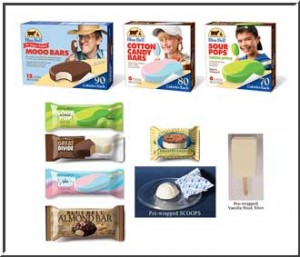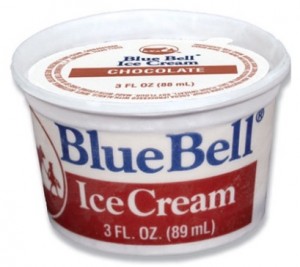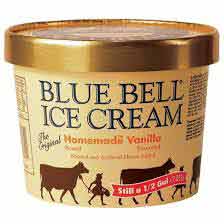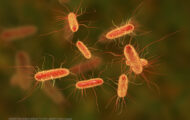The Blue Bell Listeria outbreak has sickened at least eight people in two states since 2011. All of them were hospital patients who were served contaminated ice cream during their stays. Three people have died.
The rarity of the outbreak strains is now playing a key role in helping health officials identify clusters of illness that may be associated with the ice cream.
Those at highest risk for Listeria infection are children, seniors, the immune-compromised and pregnant women. Among pregnant women, listeriosis can cause miscarriage and stillbirth.
In the month since the Blue Bell outbreak was announced by the Centers for Disease Control and Prevention (CDC) on March 13: the outbreak has expanded from one to two states; Listeria, initially associated with one troubled manufacturing line at Blue Bell’s plant in Brenham, Texas, has been found in a product made at Blue Bell’s plant in Broken Arrow, Oklahoma prompting its closure; and the company has issued three recalls.
Here is a timeline of key dates in this Listeria monocytogenes Blue Bell ice cream outbreak.
- In March 2011, the first case of this outbreak occurs at a Texas hospital that has not been named by state or federal health officials.
- In May 2011, the second case occurs at the same Texas hospital.
- In January 2014, the first Kansas case of this outbreak is reported in a patient at Via Christi hospital in Wichita.
- In March 2014, the second case is reported in Kansas.
- In October 2014, three cases are reported; two in Kansas, one in Texas.
- In January 2015, a fifth case in Kansas is reported. At this point, eight people in two states have been sickened over a four-year period and three have died but health officials are still unaware that the illnesses have a common cause.
- On February 12, 2015 during routine testing at a distribution center, the South Carolina Department of Health & Environmental Control finds Listeria in two Blue Bell products- Great Divide Bars and Chocolate Chip Country Cookie sandwiches The products were manufactured at Blue Bell’s Brenham facility.
- The Texas Department of State Health Services is alerted and conducts its own tests on product samples collected from the Brenham facility. Listeria is again found in Great Divide Bars and Chocolate Chip Country Cookie sandwiches and also found in a single-serving ice cream product, Scoops, made on the same production line.
- In early March 2015, health officials identify the Kansas cluster when they notice that two of the cases were both Via Christi patients. Using PulseNet, an inter-agency foodborne illness database, they match DNA “fingerprints” of rare Listeria isolates from the Kansas patients to those found in the ice cream samples.
- On March 9, Via Christi hospital is alerted that Listeria has been found in Blue Bell products. It removes them from circulation and holds them in quarantine. It provides invoices to the Kansas Department of Health and Environment showing that the Blue Bell brand ice cream Scoops used in the patients’ milkshakes came from Blue Bell’s facility in Texas.
- On March 13, the Centers for Disease Control and Prevention (CDC) announces an outbreak of listeriosis linked to Blue Bell ice cream served to patients at a Wichita hospital between January 2014 and January 2015. The outbreak had sickened five people, killing three of them.
- Via Christi posts information on its website saying the hospital had no knowledge the ice cream was contaminated until it was notified by health authorities on March 9 and that it has removed all Blue Bell products from circulation.
- Blue Bell posted a message on its website saying: “One of our machines produced a limited amount of frozen snacks with a potential listeria problem. When this was detected all products produced by this machine were withdrawn. Our Blue Bell team members recovered all involved products in stores and storage. This withdrawal in no way includes our half gallons, quarts, pints, cups, three gallon ice cream or take-home frozen snack novelties.”
- Blue Bell CEO Paul Kruse tells The Houston Chronicle in a March 13 story that the machine used to make Scoops and other single-serve items had not been in operation for about a month and a half, putting its shutdown days if not weeks before South Carolina’s February 12 discovery of Listeria.
- A recall is issued for 10 Blue Bell products sold at retail stores and to Blue Bell’s institutional customers such as hospitals, nursing homes and school districts. They are: Chocolate Chip Country Cookie SKU # 196, Great Divide Bar SKU #108, Sour Pop Green Apple Bar SKU #221, Cotton Candy Bar SKU #216, Scoops SKU #117, Vanilla Stick Slices SKU #964, Almond Bars SKU #156, 6 pack Cotton Candy Bars SKU #245, 6 pack Sour Pop Green Apple Bars SKU #249, and 12 pack No Sugar Added Mooo Bars* SKU #343.

The first 10 Blue Bell products recalled were made in Brenham, Texas.
- On March 15, Kruse tells KAKE.com the machine used to make the recalled products wasn’t properly sanitized and is not currently in use.
- The Texas Department of State Health Services tells Food Poisoning Bulletin that it does monthly inspections at Blue Bell’s Brenham facility. “We inspect these facility types monthly. Our last full inspection was February. “We cited a couple minor issues but nothing related to this issue,” a spokeswoman told the publication.
- Between March 13 and March 22 the Kansas Department of Health and Environment (KDHE) and the Kansas Department of Agriculture conduct tests on environmental samples from Via Christi’s kitchen and the Blue Bell products the hospital was holding in quarantine.
- None of the environmental samples from the kitchen are positive for Listeria. But an unopened Blue Bell 3-ounce single serving ice cream cup is. That contaminated ice cream cup was made at the Blue Bell’s facility in Broken Arrow, Okla.
- On March 22, the U.S. Food and Drug Administration (FDA) tells Blue Bell Listeria has been found in ice cream cups.
- On March 23, Blue Bell expands the recall to include ice cream cups. A statement on the company’s website says the contaminated cup was made in Broken Arrow on April 15, 2014. “This recall in no way includes Blue Bell Ice Cream half gallons, pints, quarts, 3 gallons or other 3 oz. cups,” the statement ends.

The second round of products Blue Bell recalled were made in Broken Arrow, Oklahoma.
- The Oklahoma Department of Agriculture, Food and Forestry (ODAFF) and the FDA begin an inspection of the Broken Arrow plant.
- On March 24, the CDC, FDA , the Kansas Department of Health and Environment (KDHE) and the Kansas Department of Agriculture publicly announce their findings that no Listeria was found in swabs taken from the Via Christi hospital kitchen but the pathogen was found in an ice cream cup made at Blue Bell’s Broken Arrow plant.
- On March 26, Food Poisoning Bulletin reports that the Oklahoma Department of Agriculture inspects the Broken Arrow plant eight times a year but chose not to test for pathogens. The focus of the inspections is overall sanitation and the pasteurization and no major problems have been discovered in these inspections, the most recent of which took place February 12, 2015 and March 17, 2015, a spokesperson told the publication.
- In Oklahoma, no illnesses have been linked to the Blue Bell Listeria outbreak, a spokesman for the Oklahoma Department of Health tells Food Poisoning Bulletin. Oklahoma had two cases of listeriosis in 2014 and one so far in 2015.
- On March 31, health officials in Alabama tell Food Poisoning Bulletin that the FDA has not been to Blue Bell’s third location in Sylacauga, AL to test products there.
- The Sylacauga plant was last inspected February 19, 2015, he tells Food Poisoning Bulletin. However, environmental swabs are not taken during those inspections, nor are products tested for specific pathogens. Instead, samples are tested for coliform and the standard plate count.
- On April 3, the CDC reports that, using PulseNet, it has identified six listeriosis patients who were sickened by the same strain of Listeria found in the Blue Bell 3 oz. cup. Four of the six patients had been hospitalized in Texas for unrelated problems before developing listeriosis. Food history information is available for one patient who reported consuming ice cream in a Texas hospital before developing listeriosis. The Texas Department of State Health Services reports that the hospital had received Blue Bell brand ice cream cups.

The third round of products recalled by Blue Bell were made in Broken Arrow, Oklahoma.
- The CDC advises consumers not to eat any products made at Blue Bell’s Broken Arrow plant. Blue Bell reports it has voluntarily suspended operations at the Oklahoma production facility.
- On April 4, 2015, Blue Bell begins working with retailers to remove all products made in the Oklahoma production facility from the market.
- On April 7, 2015, the FDA notifies Blue Bell that one of the samples it has collected in its joint inspection with Oklahoma health officials, a pint of Banana Pudding ice cream, has tested positive for Listeria.
- Blue Bell announces a third product recall that includes ice cream and sherbet pints and half gallons made at Broken Arrow from February 12, 2015 to March 27, 2015.
- On April 8, the CDC announces that further testing has confirmed that three of Texas cases are part of the outbreak. It does not name the hospital.







